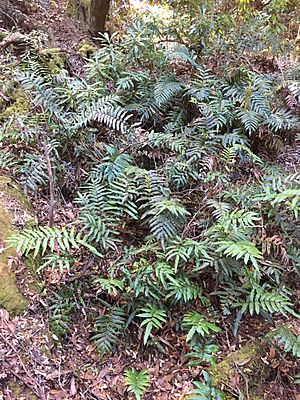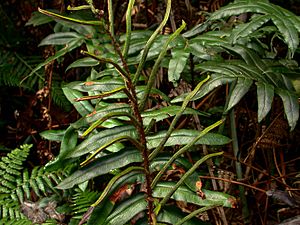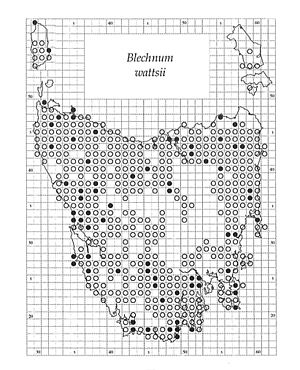Hard water fern facts for kids
Quick facts for kids Hard water fern |
|
|---|---|
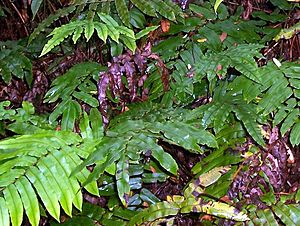 |
|
| Deua National Park, Australia | |
| Scientific classification | |
| Synonyms | |
|
The Hard water fern (scientific name: Parablechnum wattsii, also known as Blechnum wattsii) is a common type of fern. It grows on land in wet forests like rainforests and open forests. You can often spot it near creeks in many parts of southeastern Australia. This includes places like Victoria, Tasmania (and King Island), South Australia, New South Wales, and Queensland.
The fern's scientific name, wattsii, honors William Walter Watts (1856-1920). He was an expert on mosses and ferns, and over 30 species are named after him!
People call this fern by several common names:
- Hard water fern - because its fronds (leaves) are stiff and feel leathery.
- Leech fern - forest workers sometimes find leeches when they are near these ferns.
- Hard hill fern - describes where it often grows.
- Red cabbage fern - its young fronds are a bronze-pink color, looking a bit like cooked red cabbage.
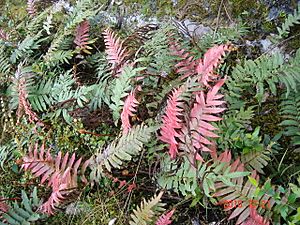
Contents
What the Hard Water Fern Looks Like
The mature hard water fern can grow quite tall, from about 30 cm to 125 cm (about 1 to 4 feet). It has large, upright fronds. This fern can spread out using underground stems called rhizomes, which creep and branch out.
Ferns in the Blechnaceae family, like the hard water fern, have two different kinds of fronds:
- Sterile fronds: These are the regular fronds that do not produce spores. When they are mature, they are dark, dull green, and feel leathery. Young sterile fronds have a pretty pink-bronze color before they turn green. The small leaf parts (pinnae) on these fronds are close together and have finely toothed edges.
- Fertile fronds: These fronds are usually longer than the sterile ones and grow in the center of the fern. They are special because they produce tiny spores, which are like seeds for ferns. The spores are found in lines on the underside of these fronds.
Reproduction and Life Cycle
The hard water fern reproduces like most ferns, going through two main life stages: the sporophyte and the gametophyte.
The fertile fronds produce many tiny spores. These spores are easy to collect and can grow into new plants. It takes about 4–6 weeks for a small, heart-shaped plant (called a prothallus) to form from a spore. Then, it takes another 6–12 months for the first true fern frond to appear.
You can also grow new ferns by carefully dividing mature plants from their root stock. This works best if you don't disturb the main underground stem too much. Sometimes, the fern can even divide naturally if its underground stem gets injured as it gets older.
Once a new hard water fern is growing, it needs damp, sheltered places with some shade to thrive.
Where the Hard Water Fern Lives
The hard water fern is found in all the southeastern states of Australia. In Tasmania, it is very common and grows from sea level up to 1000 m high.
You can find this fern in many rainforests and wet sclerophyll forests. It loves damp, shady spots, especially along creeks, rivers, and near waterfalls. This fern prefers soil that is a mix of loam and sand, drains well, and is rich in decaying plant material (humus).
Uses of the Hard Water Fern
Hard water ferns are often grown in large fern gardens, next to shaded water features, and in sheltered valleys. It's important to keep them moist, as they don't do well if they dry out.
Aboriginal Australians have traditionally used the fern's underground stems (rhizomes) as a food source. They would eat them raw or roasted, as they are rich in starch.
- Yarra Ranges Plant Directory
- DPIPWE Notesheet
See also
 In Spanish: Blechnum wattsii para niños
In Spanish: Blechnum wattsii para niños


